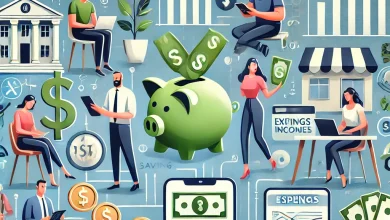Understanding Cryptocurrency and NFTs: A Beginner’s Guide
Introduction
The rise of cryptocurrency and NFTs (Non-Fungible Tokens) has changed the way people think about money, digital assets, and investment opportunities. While many are excited about the potential of blockchain technology, others find it complex and confusing.
If you’re new to crypto and NFTs, this guide will break down everything you need to know, from how they work to how you can get started.
What is Cryptocurrency?
Definition
💡 Cryptocurrency is a digital or virtual currency that uses blockchain technology to enable secure, decentralized transactions. Unlike traditional money, cryptocurrencies are not controlled by any government or central authority.
Key Features of Cryptocurrency
✔️ Decentralized: No government or bank controls it.
✔️ Secure: Uses blockchain technology for transparency and security.
✔️ Fast Transactions: Cross-border transactions without middlemen.
✔️ Limited Supply: Many cryptocurrencies have a fixed supply, reducing inflation risks.
How Does Cryptocurrency Work?
Cryptocurrency operates on blockchain technology, which is a distributed ledger that records all transactions securely.
📌 Example: Bitcoin transactions are recorded on a decentralized network where every transaction is verified by multiple nodes (computers) to prevent fraud.
Cryptocurrencies rely on blockchain technology, a decentralized digital ledger that records all transactions across a network of computers. Here’s how it works:
- Decentralization: Unlike traditional banking systems, cryptocurrencies are not controlled by a single entity. Instead, they are maintained by a network of nodes (computers) that validate and record transactions.
- Cryptography: Transactions are secured using cryptographic techniques, ensuring that they are tamper-proof and secure.
- Mining: Some cryptocurrencies, like Bitcoin, use a process called mining to validate transactions and add them to the blockchain. Miners solve complex mathematical problems to earn rewards in the form of cryptocurrency.
Popular Cryptocurrencies
🚀 Bitcoin (BTC) – The first and most well-known cryptocurrency.
🚀 Ethereum (ETH) – A blockchain that supports smart contracts and NFTs.
🚀 Binance Coin (BNB) – Used for trading and transactions on the Binance exchange.
🚀 Solana (SOL) – A fast-growing blockchain known for its low fees and high speed.
🚀 Ripple (XRP) – Designed for fast and secure cross-border payments.
What are NFTs?
Definition
💡 NFTs (Non-Fungible Tokens) are unique digital assets stored on a blockchain. Unlike cryptocurrencies, which are interchangeable, NFTs are one-of-a-kind and cannot be replaced.
How NFTs Work
NFTs use blockchain technology to verify ownership and authenticity of digital assets, such as:
🎨 Digital Art – Paintings, illustrations, and animations.
🎮 Gaming Assets – Virtual land, characters, and skins in video games.
🎵 Music and Videos – Exclusive songs, albums, or movie clips.
📜 Digital Collectibles – Trading cards, GIFs, and memorabilia.
📌 Example: The famous NFT “Everydays: The First 5000 Days” by Beeple sold for $69 million in 2021.
How to Buy Cryptocurrency and NFTs
Step 1: Choose a Crypto Exchange
🔹 Coinbase – Beginner-friendly, secure platform.
🔹 Binance – Low trading fees and a wide range of coins.
🔹 Kraken – Great for security and advanced traders.
Step 2: Create a Crypto Wallet
💼 Crypto wallets store your cryptocurrency and NFTs securely.
✔️ Hot Wallets (Online): MetaMask, Trust Wallet, Coinbase Wallet.
✔️ Cold Wallets (Offline): Ledger Nano X, Trezor.
Step 3: Buy Cryptocurrency
Use a crypto exchange to purchase Bitcoin, Ethereum, or other coins using a credit/debit card or bank transfer.
Step 4: Buy an NFT
1️⃣ Visit an NFT marketplace like OpenSea, Rarible, or Foundation.
2️⃣ Connect your crypto wallet.
3️⃣ Browse and buy NFTs using Ethereum or other supported cryptocurrencies.
Are Cryptocurrency and NFTs Safe?
Benefits
✅ Decentralization – No third-party control.
✅ Transparency – All transactions are recorded on the blockchain.
✅ Ownership – NFTs prove digital ownership of unique assets.
Risks
⚠️ Volatility: Crypto prices fluctuate rapidly.
⚠️ Scams & Frauds: Be cautious of rug pulls and fake NFT projects.
⚠️ Regulation Issues: Some governments are imposing restrictions on crypto.
📌 Tip: Always research before investing and store assets in a secure crypto wallet.
Frequently Asked Questions (FAQs)
Q1: Is cryptocurrency legal?
A: The legality of cryptocurrency varies by country. While some countries have embraced it, others have imposed restrictions or bans.
Q2: Can I create my own NFT?
A: Yes, anyone can create an NFT by minting it on an NFT marketplace.
Q3: What is the difference between Bitcoin and Ethereum?
A: Bitcoin is primarily a digital currency, while Ethereum is a platform for decentralized applications and smart contracts.
Q4: Are NFTs a good investment?
A: NFTs can be profitable, but they are also highly speculative. Always do thorough research before investing.
Future of Cryptocurrency and NFTs
🚀 Crypto adoption is growing – More businesses and countries are accepting Bitcoin.
🎮 NFTs in gaming – Play-to-earn games like Axie Infinity are revolutionizing the gaming industry.
🏛️ Regulation is evolving – Governments are working on crypto-friendly laws to ensure investor protection.
📌 Conclusion: Cryptocurrency and NFTs are here to stay, offering exciting opportunities for investment and innovation. If you’re new, start by learning, researching, and investing wisely.



